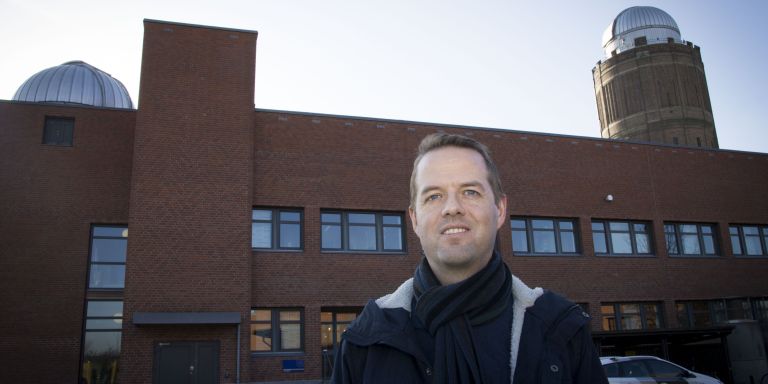
Anders Johansen
Professor of Astronomy
Wallenberg Scholar
Institution:
Lund University
Research field:
Planet formation


Wallenberg Scholar
Institution:
Lund University
Research field:
Planet formation
On January 1, 2019, the New Horizon space probe passed by Arrokoth, a small planet in the Kuiper Belt beyond Pluto. The belt consists of the remains from the formation of our solar system 4.5 billion years ago. A journey there is like traveling back in time to the birth of the solar system.
The images of Arrokoth captured by New Horizon show a double ice-asteroid in the shape of a snowman. The fact that the asteroid comprises two merged spheres confounds earlier ideas of how planets form. The images also confirm the theory propounded by Johansen when he was a doctoral student.
“It was great to see. When I published my thesis I was so heavily criticized that I started to think there was a bug in my program,” Johansen recalls.
The theory that NASA now considers can be abandoned postulates that small planets like Arrokoth are the result of violent cosmic collisions. One problem with that theory has always been that the enormous violence of the collision would smash the planet to pieces. NASA’s images instead showed the result of a very slow collision.
“The snowman consists of two perfect spheres that are joined together. To be resting together like that, they must have collided at very low speed – roughly at walking pace.”
Johansen is attempting to figure out how planets are formed, but not with the aid of a telescope; he is using computer simulations. For his doctoral thesis he developed software that mimics the state of our solar system just after the sun had been formed.
At that time the sun was surrounded by a swirling disk of gas and dust. Particles collided; some adhered to each other, forming tiny pebbles only a millimeter or so across.
“The consistency of these pebbles was like compacted flour. You can make it into small balls, but it falls apart very easily,” he explains.
So what makes the pebbles grow larger? Johansen’s simulation showed how the friction in the gas and particles interacted, resulting in small but growing heavenly bodies.
“This has nothing to do with gravity, it’s a bit like the peloton in a cycle race – they bunch together to reduce wind resistance. There is an energy gain in forming dense groups, which is also what causes them to form.”
The phenomenon is known as “streaming instability”. When the clumps grow, they are soon aided by gravity. When they have grown to the size of Arrokoth, they have a diameter of up to 100 kilometers, and are known as planetesimals. There are thousands of them in the Kuiper Belt – relics from the birth of the solar system.
Johansen’s simulation showed that Arrokoth formed as a “binary planetesimal” before colliding at low speed to form a “contact planetesimal”.
When Johansen began his studies at the University of Copenhagen, physics and mathematics were on the agenda. But he soon found mathematics to be rather too abstract for his taste.
“One of my fellow students was studying astronomy, and it seemed really cool. I found it inspiring to question the origin of things – it enabled me to use my intuition.”
He now divides his time between Lund University and the Globe Institute at the University of Copenhagen. With the help of computer simulations, he has continued to study how planetesimals evolve into ever larger planets. His research shows how the grains of rock continued to play a central role when planets such as Jupiter, Saturn and Earth formed.
The growing planets can be likened to large vacuum cleaners, sucking in small pebbles from space by virtue of their gravity. The pebbles are robbed of their kinetic energy by friction as they move through the gas, causing them to fall to the surface of the planet. The theory is termed “pebble accretion”.
“These days pebble accretion is bandied about at astronomy conferences as though it were one of Newton’s laws. For me it’s a surreal feeling – sometimes I have to shake my head. But sure, I really have achieved something with my research.”
“Receiving the grant is a luxury. It gives me enormous flexibility to develop new projects and establish research teams. In addition, the accompanying mentor program has given me a way into the Swedish research community.”
Over the past few years Johansen has developed computer models to show how Earth has evolved from an inhospitable, icy planet. The rain of pebbles heated up the surface, and volatile substances such as water and carbon molecules evaporated; iron melted and sank to the center. The process is called differentiation, and is now being simulated on the computer.
“I’m working on a code to compute the entire process – it seems really promising. It will show that Earth was formed in only five million years, not fifty million years as was previously thought.”
He knows this conclusion will be sharply criticized by other researchers. But he applauds the scientific process.
“It takes a long time to persuade other researchers that a new theory is right. You have to go through a whole machinery of criticism and articles in rebuttal. But this is a good thing; it’s vital to have high standards. They require you to listen to the criticism, hone your arguments and revisit your data.”
The pebble accretion theory may ultimately make it easier to look for life elsewhere in the universe.
“When we find evidence of life on other planets, it will transform our culture – we’ll have a completely different mindset,” Johansen says.
Text Magnus Trogen Pahén
Translation Maxwell Arding
Photo Johan Joelsson, Kennet Ruona, Lena Björk Blixt, Magnus Bergström